
Monarda didyma, the crimson beebalm, scarlet beebalm, scarlet monarda, Eau-de-Cologne plant, Oswego tea, or bergamot, is an aromatic herb in the family Lamiaceae, native to eastern North America from Maine west to Ontario and Minnesota, and south to northern Georgia. Its odor is considered similar to that of the bergamot orange. The genus name comes from Nicolas Monardes, who described the first American flora in 1569.

Monarda is a genus of flowering plants in the mint family, Lamiaceae. The genus is endemic to North America. Common names include bergamot, bee balm, horsemint, oswego tea, the first inspired by the fragrance of the leaves, which is reminiscent of bergamot orange. The genus was named for the Spanish botanist Nicolás Monardes, who wrote a book in 1574 describing plants of the New World.
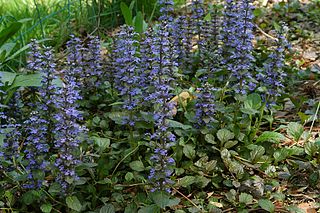
Ajuga reptans is commonly known as bugle, blue bugle, bugleherb, bugleweed, carpetweed, carpet bugleweed, and common bugle, and traditionally but less commonly as St. Lawrence plant. It is an herbaceous flowering plant, in the mint family, native to Europe. It is invasive in parts of North America. Ajuga reptans is also a component of purple moor grass and rush pastures, a Biodiversity Action Plan habitat in the United Kingdom.

Monarda citriodora is a species of flowering plant in the mint family, Lamiaceae, that is native to the southern United States and northern Mexico. Common names include lemon beebalm, lemon mint and purple horsemint. When crushed, the leaves emit an odor reminiscent of lemons. This odor is sometimes described as more resembling oregano, especially late in the season. Its purple flowers are highly attractive to butterflies, bees and hummingbirds.

Cirsium edule, the edible thistle or Indian thistle, is a species of thistle in the genus Cirsium, native to western North America from southeastern Alaska south through British Columbia to Washington and Oregon, and locally inland to Idaho. It is a larval host to the mylitta crescent and the painted lady.

Packera obovata, the roundleaf ragwort or spoon-leaved ragwort, is an erect perennial herb native to eastern North America. It was previously called Senecio obovatus. Basal and lower leaves are obovate with toothed margins, while upper leaves are pinnately divided. The ray flowers are yellow and the disk flowers orange-yellow, the inflorescences being held well above the foliage.

Rudbeckia fulgida, the orange coneflower or perennial coneflower, is a species of flowering plant in the family Asteraceae, native to eastern North America.

Stachys byzantina, the lamb's-ear or woolly hedgenettle, is a species of flowering plant in the mint family Lamiaceae, native to Armenia, Iran, and Turkey. It is cultivated over much of the temperate world as an ornamental plant, and is naturalised in some locations as an escapee from gardens. Plants are very often found under the synonym Stachys lanata or Stachys olympica.

Echinacea purpurea, the eastern purple coneflower, purple coneflower, hedgehog coneflower, or echinacea, is a North American species of flowering plant in the family Asteraceae. It is native to parts of eastern North America and present to some extent in the wild in much of the eastern, southeastern and midwestern United States as well as in the Canadian Province of Ontario. It is most common in the Ozarks and in the Mississippi/Ohio Valley. Its habitats include dry open woods, prairies and barrens.
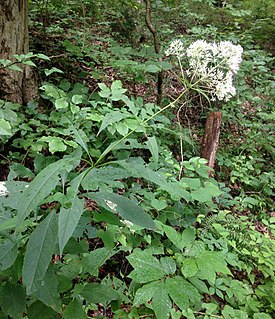
Eutrochium purpureum, commonly known as purple Joe-Pye weed or sweetscented joe pye weed, is an herbaceous perennial plant in the family Asteraceae. It is native to eastern and central North America, from Ontario east to New Hampshire and south as far as Florida, Louisiana, and Oklahoma.

Lonicera sempervirens is a species of honeysuckle vine native to the eastern United States which is known for its reddish flowers.

Penstemon digitalis is a species of flowering plant in the plantain family, Plantaginaceae. The flowers are white and are borne in summer. It is native to eastern Canada and the eastern and southeastern United States. Penstemon digitalis is the most widespread species of Penstemon east of the Mississippi River.

Erigeron annuus, the annual fleabane, daisy fleabane, or eastern daisy fleabane, is a species of herbaceous, annual or biennial flowering plant in the family Asteraceae.

Cirsium discolor, the field thistle, is a North American species of plants in the tribe Cardueae within the family Asteraceae. It is native to thirty-three states in the United States as well four Canadian provinces. It occurs across much of eastern and central Canada as well as eastern and central United States. It has been found from New Brunswick west to Saskatchewan and south as far as Texas and Georgia.
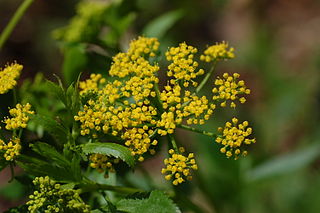
Zizia aurea is a flowering herbaceous perennial plant of the carrot family Apiaceae. It is native to eastern Canada and the United States, from the eastern Great Plains to the Atlantic Coast. It is named for Johann Baptist Ziz, a German botanist.
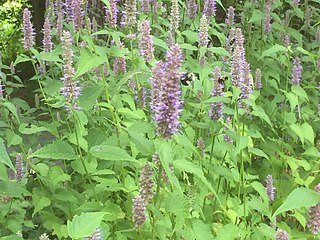
Agastache foeniculum, commonly called anise hyssop, blue giant hyssop, Fragrant giant hyssop, or the lavender giant hyssop, is a species of perennial plant in the mint family, (Lamiaceae). This plant is native to much of north-central and northern North America, notably the Great Plains and other prairies. It is tolerant of deer and drought, and also attracts hummingbirds, butterflies, bumblebees, honey bees, carpenter bees, and night flying moths.

Blephilia hirsuta is an herbaceous perennial of the mint family Lamiaceae native to eastern North America. It is commonly called hairy wood-mint or hairy pagoda plant.

Symphyotrichum georgianum is a rare species of flowering plant in the Asteraceae, the aster family. Its common name is Georgia aster. It is native to the southeastern United States where it is known from Alabama, Florida, Georgia, North Carolina, and South Carolina. As of 2013, it may be extirpated from the state of Florida.
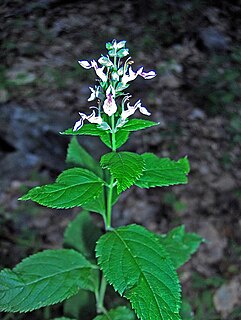
Teucrium canadense, commonly known as Canada germander, American germander or wood sage, is a perennial herb in the family Lamiaceae. It is native to North America where it is found across the contiguous states of the United States and in much of Canada.

Monarda clinopodia, commonly known as white bergamot, basil bee balm or white bee balm, is a perennial wildflower in the mint family, Lamiaceae. This species is native to North America, ranging north from New York, west to Missouri, and south to Georgia and Alabama. M. clinopodia has also been introduced into Vermont and Massachusetts.





















